A Comparative Study of Social Media Theories: Behaviour, Identity
VerifiedAdded on 2024/06/28
|10
|1773
|112
Essay
AI Summary
This essay provides an analysis and comparison of three key social media theories: the theory of planned behavior, social identity theory, and media richness theory. The theory of planned behavior explains individual human behaviors based on factors like attitude, subjective norms, and perceived behavioral control. Social identity theory explores how individuals identify with social groups and develop a sense of self and collective identity. Media richness theory focuses on the ability of communication mediums to accurately reproduce information, linking media characteristics to task requirements. The essay contrasts personal behavior theories with social behavior theories, highlighting their focus on individuals versus societal levels, and differentiates them from mass communication theories that emphasize organizational-level communication and information clarity. Desklib offers a range of resources, including past papers and solved assignments, to aid students in their understanding of these concepts.

Paraphrase This Document
Need a fresh take? Get an instant paraphrase of this document with our AI Paraphraser
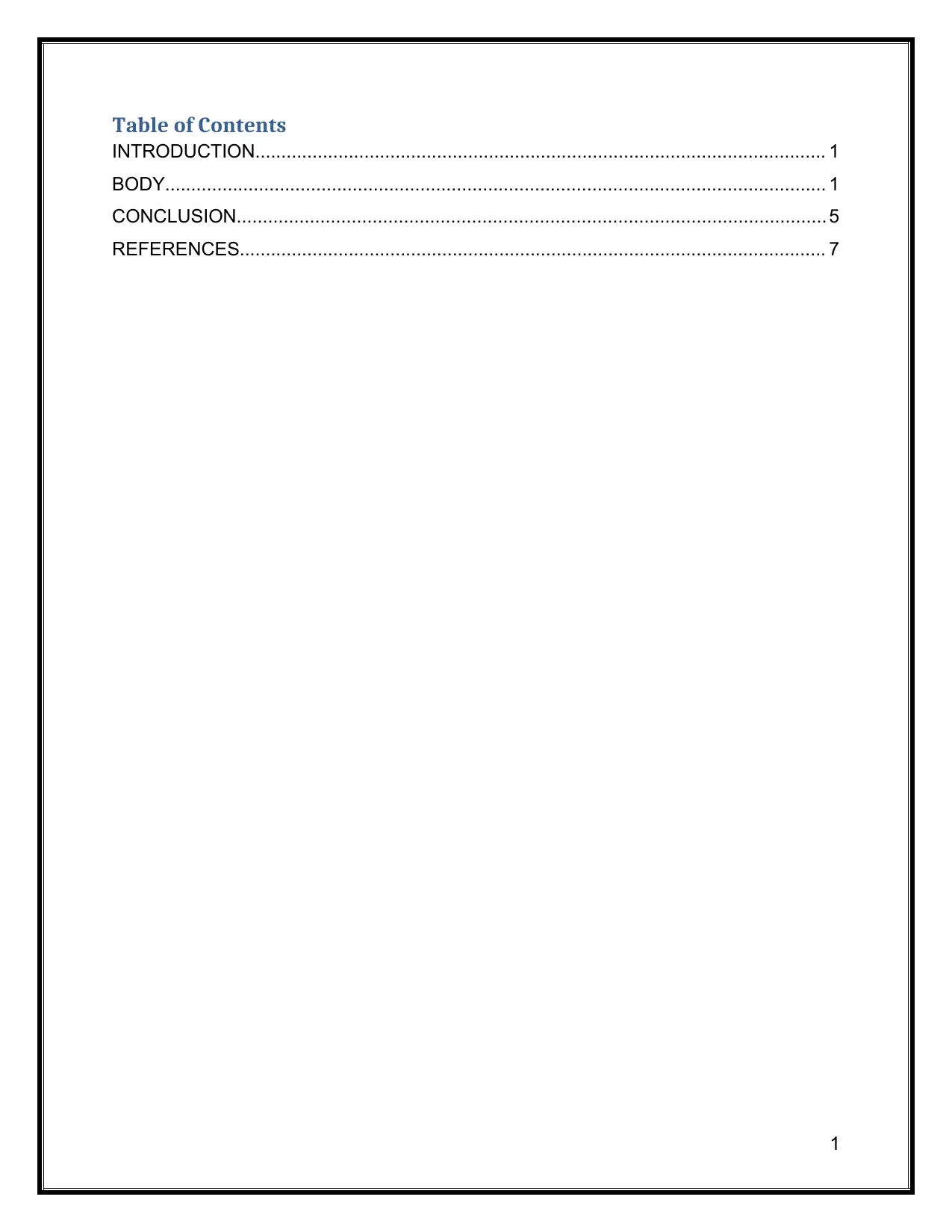
Table of Contents
INTRODUCTION.............................................................................................................. 1
BODY............................................................................................................................... 1
CONCLUSION................................................................................................................. 5
REFERENCES................................................................................................................. 7
1
INTRODUCTION.............................................................................................................. 1
BODY............................................................................................................................... 1
CONCLUSION................................................................................................................. 5
REFERENCES................................................................................................................. 7
1
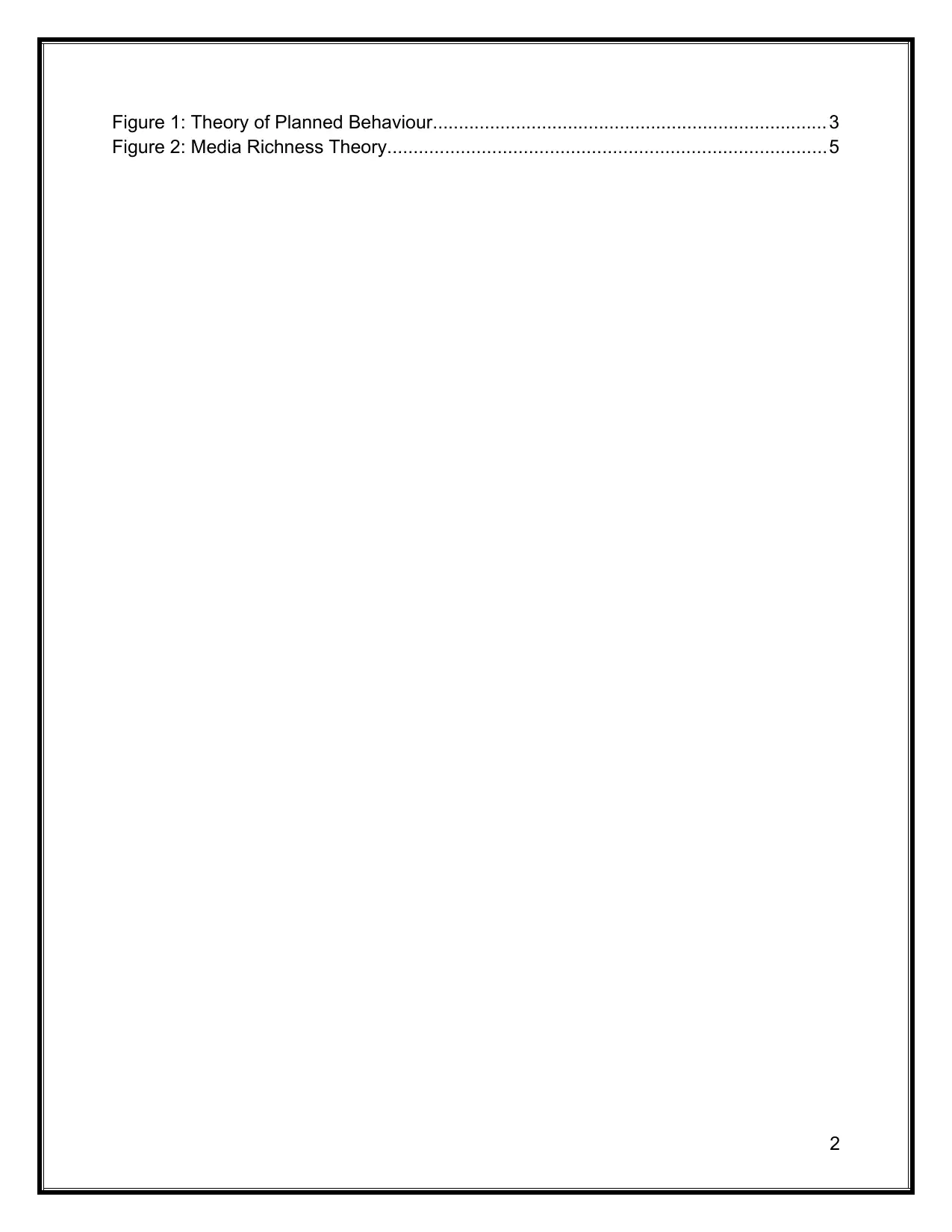
Figure 1: Theory of Planned Behaviour............................................................................ 3
Figure 2: Media Richness Theory....................................................................................5
2
Figure 2: Media Richness Theory....................................................................................5
2
⊘ This is a preview!⊘
Do you want full access?
Subscribe today to unlock all pages.

Trusted by 1+ million students worldwide
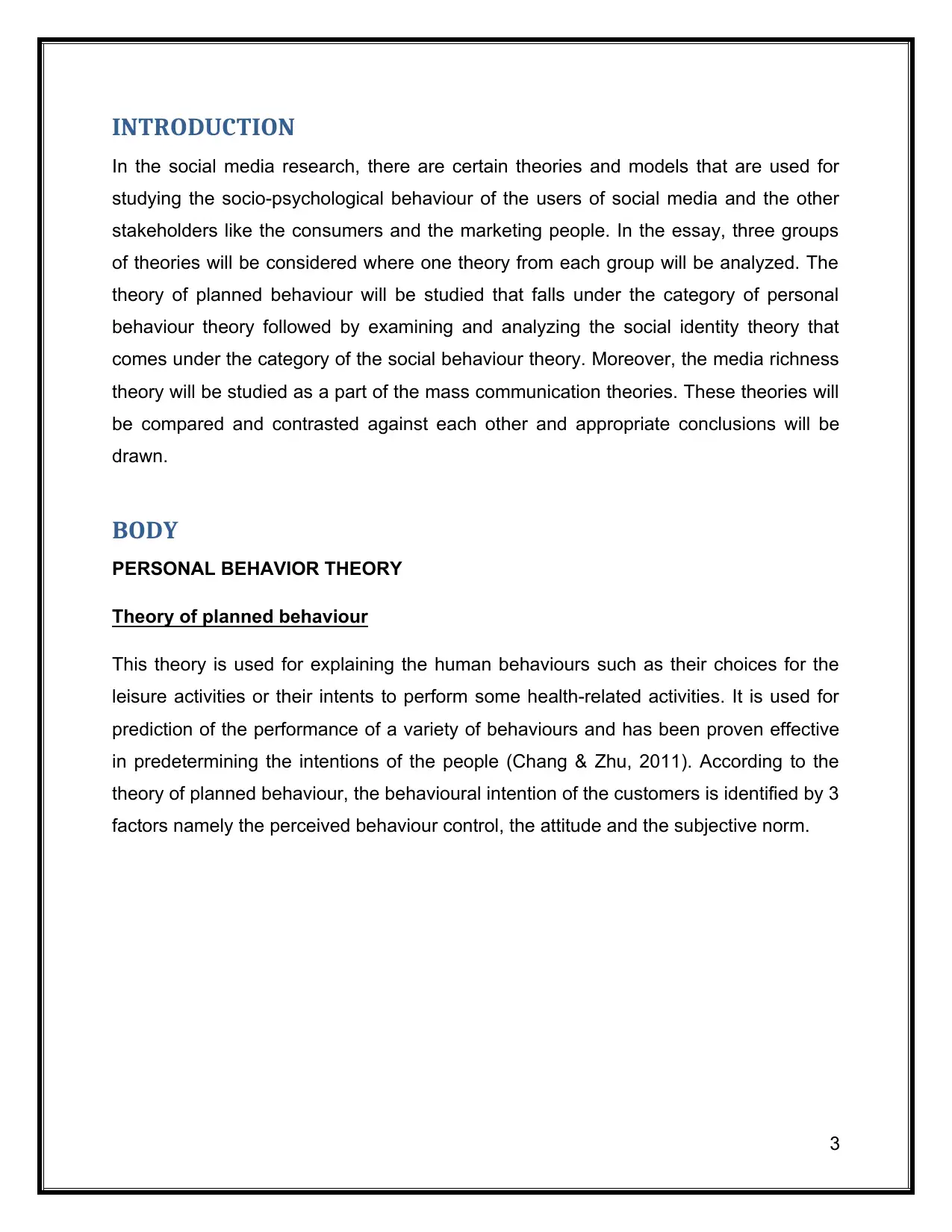
INTRODUCTION
In the social media research, there are certain theories and models that are used for
studying the socio-psychological behaviour of the users of social media and the other
stakeholders like the consumers and the marketing people. In the essay, three groups
of theories will be considered where one theory from each group will be analyzed. The
theory of planned behaviour will be studied that falls under the category of personal
behaviour theory followed by examining and analyzing the social identity theory that
comes under the category of the social behaviour theory. Moreover, the media richness
theory will be studied as a part of the mass communication theories. These theories will
be compared and contrasted against each other and appropriate conclusions will be
drawn.
BODY
PERSONAL BEHAVIOR THEORY
Theory of planned behaviour
This theory is used for explaining the human behaviours such as their choices for the
leisure activities or their intents to perform some health-related activities. It is used for
prediction of the performance of a variety of behaviours and has been proven effective
in predetermining the intentions of the people (Chang & Zhu, 2011). According to the
theory of planned behaviour, the behavioural intention of the customers is identified by 3
factors namely the perceived behaviour control, the attitude and the subjective norm.
3
In the social media research, there are certain theories and models that are used for
studying the socio-psychological behaviour of the users of social media and the other
stakeholders like the consumers and the marketing people. In the essay, three groups
of theories will be considered where one theory from each group will be analyzed. The
theory of planned behaviour will be studied that falls under the category of personal
behaviour theory followed by examining and analyzing the social identity theory that
comes under the category of the social behaviour theory. Moreover, the media richness
theory will be studied as a part of the mass communication theories. These theories will
be compared and contrasted against each other and appropriate conclusions will be
drawn.
BODY
PERSONAL BEHAVIOR THEORY
Theory of planned behaviour
This theory is used for explaining the human behaviours such as their choices for the
leisure activities or their intents to perform some health-related activities. It is used for
prediction of the performance of a variety of behaviours and has been proven effective
in predetermining the intentions of the people (Chang & Zhu, 2011). According to the
theory of planned behaviour, the behavioural intention of the customers is identified by 3
factors namely the perceived behaviour control, the attitude and the subjective norm.
3
Paraphrase This Document
Need a fresh take? Get an instant paraphrase of this document with our AI Paraphraser
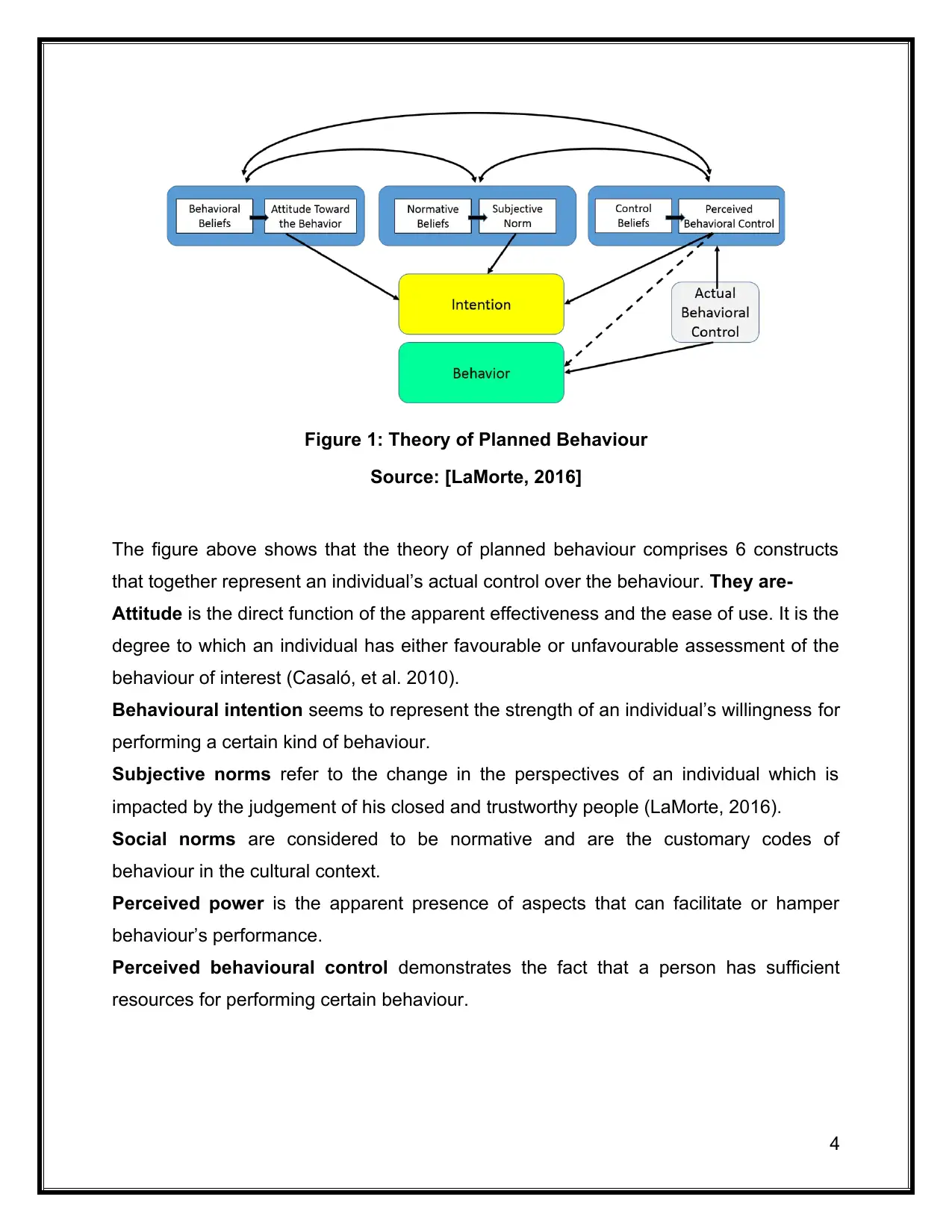
Figure 1: Theory of Planned Behaviour
Source: [LaMorte, 2016]
The figure above shows that the theory of planned behaviour comprises 6 constructs
that together represent an individual’s actual control over the behaviour. They are-
Attitude is the direct function of the apparent effectiveness and the ease of use. It is the
degree to which an individual has either favourable or unfavourable assessment of the
behaviour of interest (Casaló, et al. 2010).
Behavioural intention seems to represent the strength of an individual’s willingness for
performing a certain kind of behaviour.
Subjective norms refer to the change in the perspectives of an individual which is
impacted by the judgement of his closed and trustworthy people (LaMorte, 2016).
Social norms are considered to be normative and are the customary codes of
behaviour in the cultural context.
Perceived power is the apparent presence of aspects that can facilitate or hamper
behaviour’s performance.
Perceived behavioural control demonstrates the fact that a person has sufficient
resources for performing certain behaviour.
4
Source: [LaMorte, 2016]
The figure above shows that the theory of planned behaviour comprises 6 constructs
that together represent an individual’s actual control over the behaviour. They are-
Attitude is the direct function of the apparent effectiveness and the ease of use. It is the
degree to which an individual has either favourable or unfavourable assessment of the
behaviour of interest (Casaló, et al. 2010).
Behavioural intention seems to represent the strength of an individual’s willingness for
performing a certain kind of behaviour.
Subjective norms refer to the change in the perspectives of an individual which is
impacted by the judgement of his closed and trustworthy people (LaMorte, 2016).
Social norms are considered to be normative and are the customary codes of
behaviour in the cultural context.
Perceived power is the apparent presence of aspects that can facilitate or hamper
behaviour’s performance.
Perceived behavioural control demonstrates the fact that a person has sufficient
resources for performing certain behaviour.
4
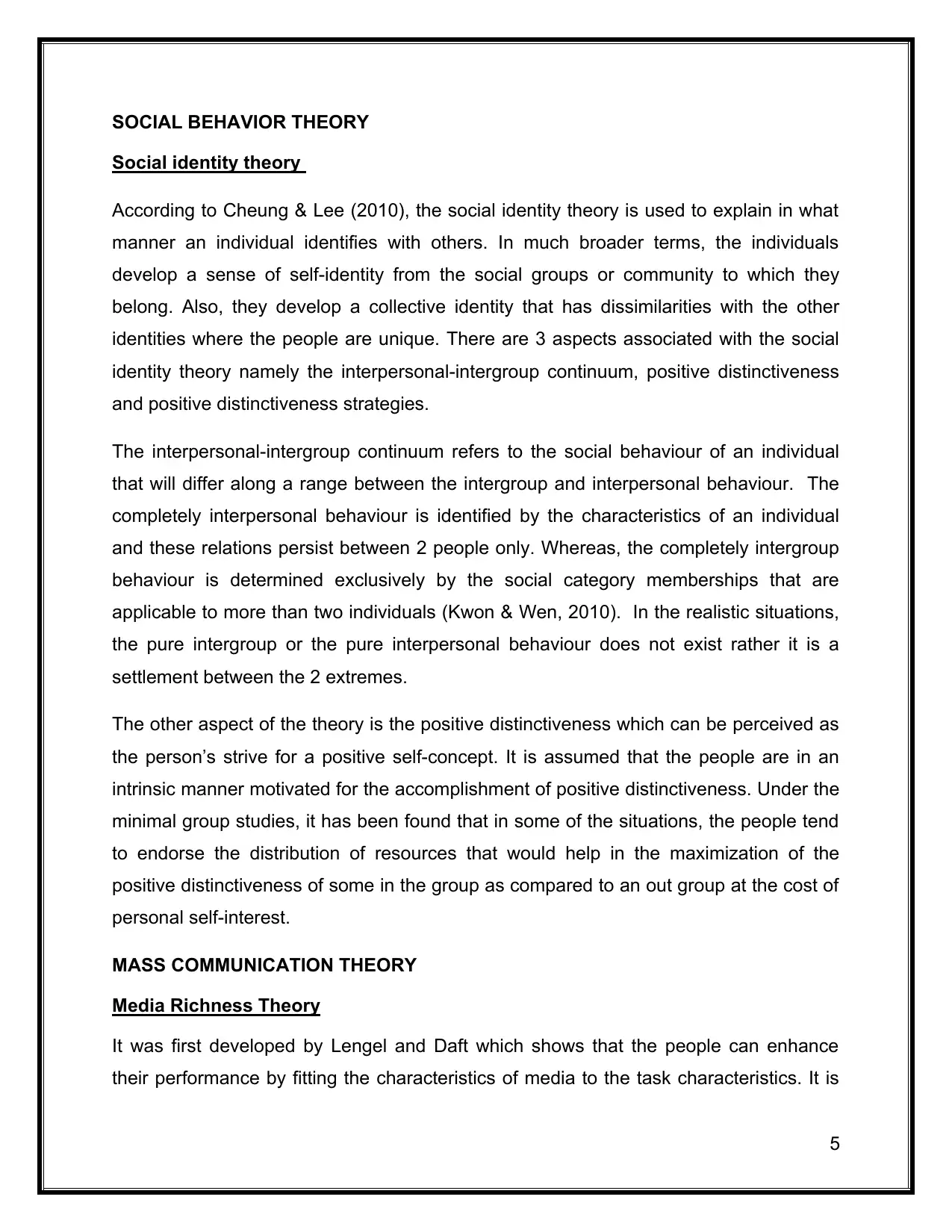
SOCIAL BEHAVIOR THEORY
Social identity theory
According to Cheung & Lee (2010), the social identity theory is used to explain in what
manner an individual identifies with others. In much broader terms, the individuals
develop a sense of self-identity from the social groups or community to which they
belong. Also, they develop a collective identity that has dissimilarities with the other
identities where the people are unique. There are 3 aspects associated with the social
identity theory namely the interpersonal-intergroup continuum, positive distinctiveness
and positive distinctiveness strategies.
The interpersonal-intergroup continuum refers to the social behaviour of an individual
that will differ along a range between the intergroup and interpersonal behaviour. The
completely interpersonal behaviour is identified by the characteristics of an individual
and these relations persist between 2 people only. Whereas, the completely intergroup
behaviour is determined exclusively by the social category memberships that are
applicable to more than two individuals (Kwon & Wen, 2010). In the realistic situations,
the pure intergroup or the pure interpersonal behaviour does not exist rather it is a
settlement between the 2 extremes.
The other aspect of the theory is the positive distinctiveness which can be perceived as
the person’s strive for a positive self-concept. It is assumed that the people are in an
intrinsic manner motivated for the accomplishment of positive distinctiveness. Under the
minimal group studies, it has been found that in some of the situations, the people tend
to endorse the distribution of resources that would help in the maximization of the
positive distinctiveness of some in the group as compared to an out group at the cost of
personal self-interest.
MASS COMMUNICATION THEORY
Media Richness Theory
It was first developed by Lengel and Daft which shows that the people can enhance
their performance by fitting the characteristics of media to the task characteristics. It is
5
Social identity theory
According to Cheung & Lee (2010), the social identity theory is used to explain in what
manner an individual identifies with others. In much broader terms, the individuals
develop a sense of self-identity from the social groups or community to which they
belong. Also, they develop a collective identity that has dissimilarities with the other
identities where the people are unique. There are 3 aspects associated with the social
identity theory namely the interpersonal-intergroup continuum, positive distinctiveness
and positive distinctiveness strategies.
The interpersonal-intergroup continuum refers to the social behaviour of an individual
that will differ along a range between the intergroup and interpersonal behaviour. The
completely interpersonal behaviour is identified by the characteristics of an individual
and these relations persist between 2 people only. Whereas, the completely intergroup
behaviour is determined exclusively by the social category memberships that are
applicable to more than two individuals (Kwon & Wen, 2010). In the realistic situations,
the pure intergroup or the pure interpersonal behaviour does not exist rather it is a
settlement between the 2 extremes.
The other aspect of the theory is the positive distinctiveness which can be perceived as
the person’s strive for a positive self-concept. It is assumed that the people are in an
intrinsic manner motivated for the accomplishment of positive distinctiveness. Under the
minimal group studies, it has been found that in some of the situations, the people tend
to endorse the distribution of resources that would help in the maximization of the
positive distinctiveness of some in the group as compared to an out group at the cost of
personal self-interest.
MASS COMMUNICATION THEORY
Media Richness Theory
It was first developed by Lengel and Daft which shows that the people can enhance
their performance by fitting the characteristics of media to the task characteristics. It is
5
⊘ This is a preview!⊘
Do you want full access?
Subscribe today to unlock all pages.

Trusted by 1+ million students worldwide
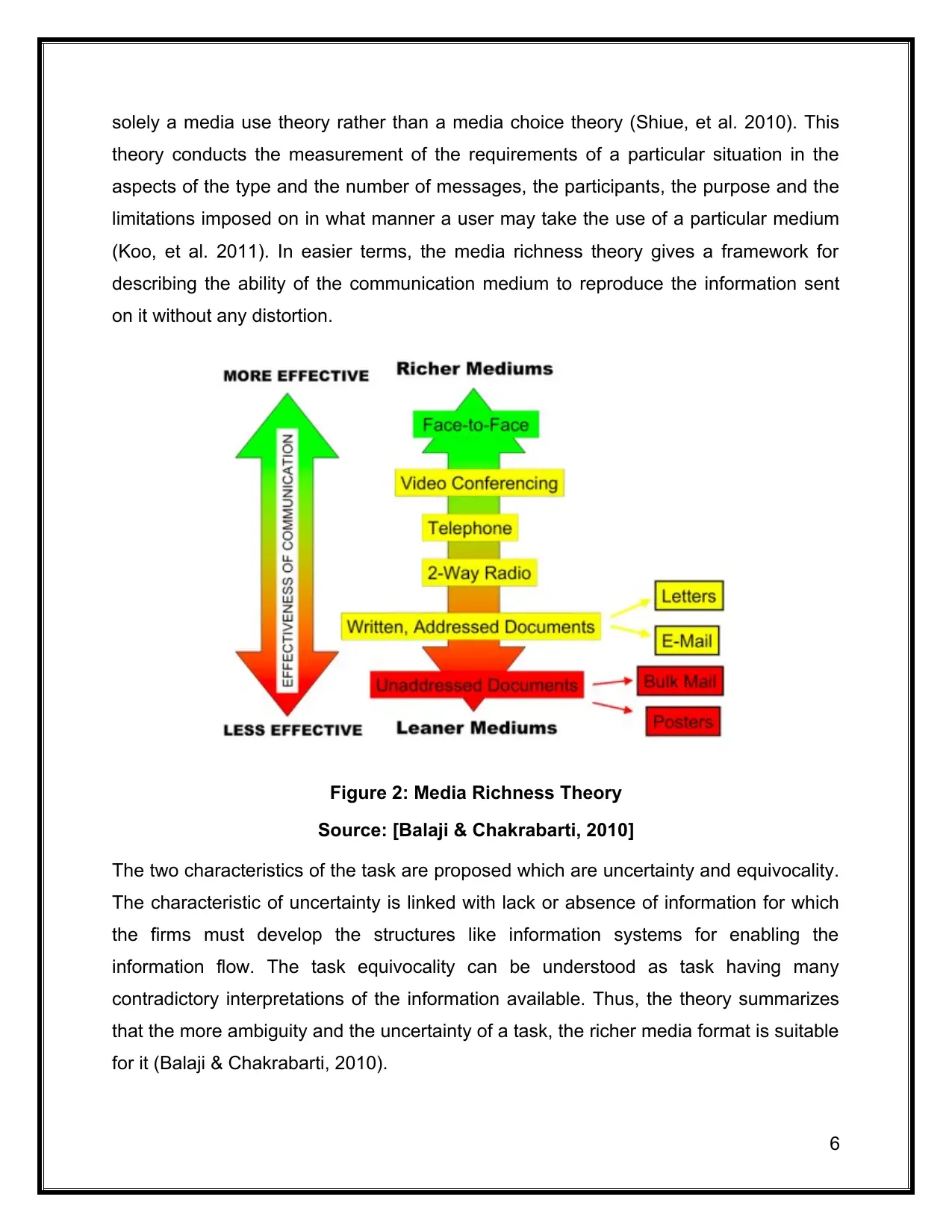
solely a media use theory rather than a media choice theory (Shiue, et al. 2010). This
theory conducts the measurement of the requirements of a particular situation in the
aspects of the type and the number of messages, the participants, the purpose and the
limitations imposed on in what manner a user may take the use of a particular medium
(Koo, et al. 2011). In easier terms, the media richness theory gives a framework for
describing the ability of the communication medium to reproduce the information sent
on it without any distortion.
Figure 2: Media Richness Theory
Source: [Balaji & Chakrabarti, 2010]
The two characteristics of the task are proposed which are uncertainty and equivocality.
The characteristic of uncertainty is linked with lack or absence of information for which
the firms must develop the structures like information systems for enabling the
information flow. The task equivocality can be understood as task having many
contradictory interpretations of the information available. Thus, the theory summarizes
that the more ambiguity and the uncertainty of a task, the richer media format is suitable
for it (Balaji & Chakrabarti, 2010).
6
theory conducts the measurement of the requirements of a particular situation in the
aspects of the type and the number of messages, the participants, the purpose and the
limitations imposed on in what manner a user may take the use of a particular medium
(Koo, et al. 2011). In easier terms, the media richness theory gives a framework for
describing the ability of the communication medium to reproduce the information sent
on it without any distortion.
Figure 2: Media Richness Theory
Source: [Balaji & Chakrabarti, 2010]
The two characteristics of the task are proposed which are uncertainty and equivocality.
The characteristic of uncertainty is linked with lack or absence of information for which
the firms must develop the structures like information systems for enabling the
information flow. The task equivocality can be understood as task having many
contradictory interpretations of the information available. Thus, the theory summarizes
that the more ambiguity and the uncertainty of a task, the richer media format is suitable
for it (Balaji & Chakrabarti, 2010).
6
Paraphrase This Document
Need a fresh take? Get an instant paraphrase of this document with our AI Paraphraser

COMPARE AND CONTRAST OF THEORIES
The personal behaviour theories among which the theory of planned behaviour fall
depicts the behaviour of a human at the individual level. This can be influenced by the
attitude of the person, the expectations of the other people regarding the individual’s
behaviour and the availability of the resources to an individual to showcase a certain
type of behaviour. In a similar manner, the social identity theory also explains the
behaviour of the individuals but at the social level rather than at the individual scale
(LaMorte, 2016). So, despite having similarity between the theory of planned behaviour
and the social identity theory it differentiates as the social identity theory gives an insight
into how an individual identifies with the others at a societal level. Also, in the social
identity theory, the person perceives that he/she belongs to a certain group of society
and their relationship with them has a significant value (Casaló, et al. 2010).
On the other hand, the media richness theory is far different from both the theories as
this theory is concerned with the communication and the task characteristics. The social
and personal behaviour theories are focused on particular individuals and did not lay
emphasis on an organization as a whole. While, the mass communication theory
completely relates at the organisational level and depicts the reliability and efficiency of
the information which is sent from one place to the other (Koo, et al. 2011). It
specifically illustrates the richness of the media with the clarity of the information.
CONCLUSION
The advent of social media has led to a revolution in the lives of individuals as well as at
the Industrial level. The theories of social media play a significant role in impacting the
individuals at the personal and organisational level. The theory of personal behaviour
has been discussed by taking into context the theory of planned behaviour which shows
that individuals have a certain set of choices and act according to their preferences. The
social identity theory signifies that the people showcase a certain set of behaviour and
develop their identity according to the social group in which they live. On the other hand,
the media richness theory has concluded that the richness of the media shows the
7
The personal behaviour theories among which the theory of planned behaviour fall
depicts the behaviour of a human at the individual level. This can be influenced by the
attitude of the person, the expectations of the other people regarding the individual’s
behaviour and the availability of the resources to an individual to showcase a certain
type of behaviour. In a similar manner, the social identity theory also explains the
behaviour of the individuals but at the social level rather than at the individual scale
(LaMorte, 2016). So, despite having similarity between the theory of planned behaviour
and the social identity theory it differentiates as the social identity theory gives an insight
into how an individual identifies with the others at a societal level. Also, in the social
identity theory, the person perceives that he/she belongs to a certain group of society
and their relationship with them has a significant value (Casaló, et al. 2010).
On the other hand, the media richness theory is far different from both the theories as
this theory is concerned with the communication and the task characteristics. The social
and personal behaviour theories are focused on particular individuals and did not lay
emphasis on an organization as a whole. While, the mass communication theory
completely relates at the organisational level and depicts the reliability and efficiency of
the information which is sent from one place to the other (Koo, et al. 2011). It
specifically illustrates the richness of the media with the clarity of the information.
CONCLUSION
The advent of social media has led to a revolution in the lives of individuals as well as at
the Industrial level. The theories of social media play a significant role in impacting the
individuals at the personal and organisational level. The theory of personal behaviour
has been discussed by taking into context the theory of planned behaviour which shows
that individuals have a certain set of choices and act according to their preferences. The
social identity theory signifies that the people showcase a certain set of behaviour and
develop their identity according to the social group in which they live. On the other hand,
the media richness theory has concluded that the richness of the media shows the
7

clarity of the communication and the information sent over a particular medium from one
group of people to the other.
8
group of people to the other.
8
⊘ This is a preview!⊘
Do you want full access?
Subscribe today to unlock all pages.

Trusted by 1+ million students worldwide
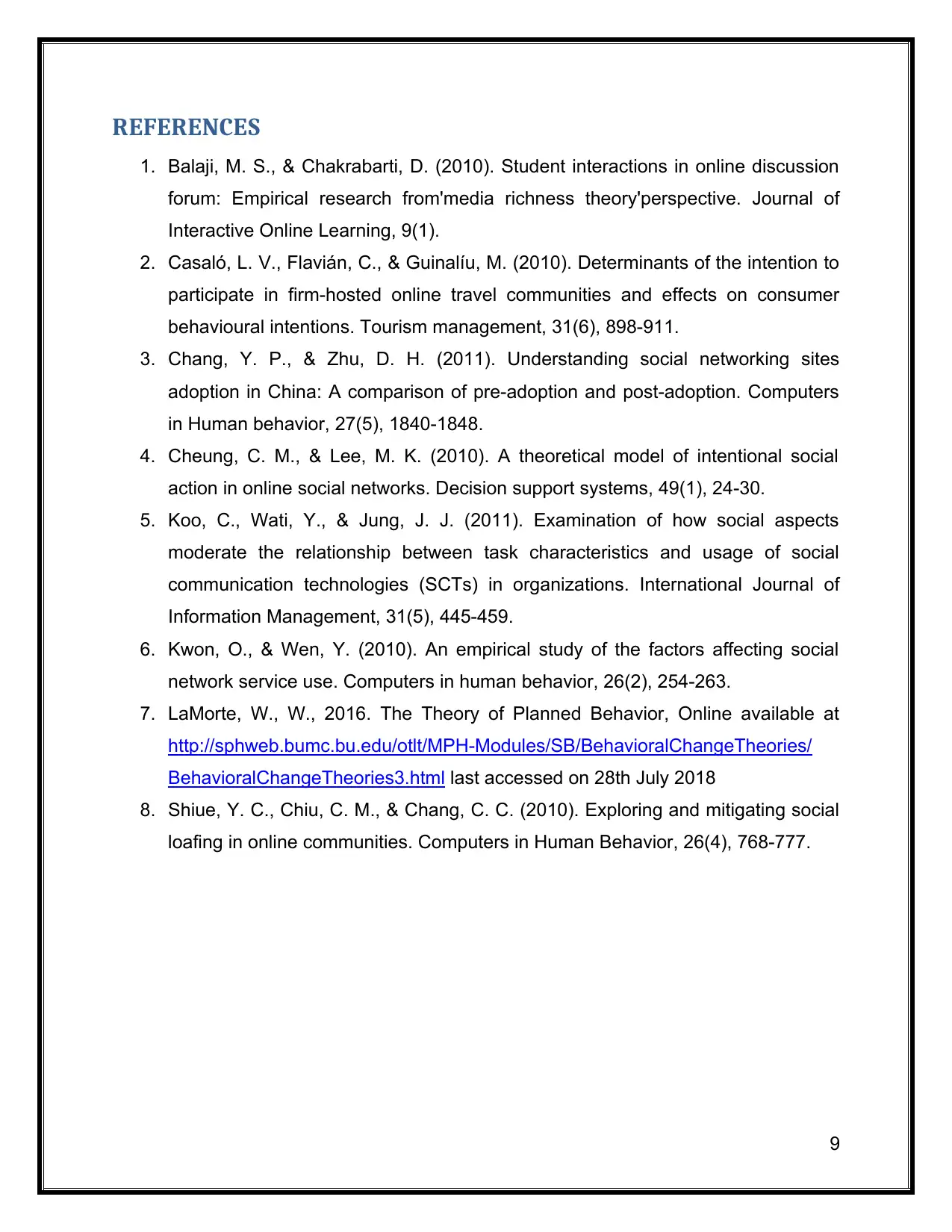
REFERENCES
1. Balaji, M. S., & Chakrabarti, D. (2010). Student interactions in online discussion
forum: Empirical research from'media richness theory'perspective. Journal of
Interactive Online Learning, 9(1).
2. Casaló, L. V., Flavián, C., & Guinalíu, M. (2010). Determinants of the intention to
participate in firm-hosted online travel communities and effects on consumer
behavioural intentions. Tourism management, 31(6), 898-911.
3. Chang, Y. P., & Zhu, D. H. (2011). Understanding social networking sites
adoption in China: A comparison of pre-adoption and post-adoption. Computers
in Human behavior, 27(5), 1840-1848.
4. Cheung, C. M., & Lee, M. K. (2010). A theoretical model of intentional social
action in online social networks. Decision support systems, 49(1), 24-30.
5. Koo, C., Wati, Y., & Jung, J. J. (2011). Examination of how social aspects
moderate the relationship between task characteristics and usage of social
communication technologies (SCTs) in organizations. International Journal of
Information Management, 31(5), 445-459.
6. Kwon, O., & Wen, Y. (2010). An empirical study of the factors affecting social
network service use. Computers in human behavior, 26(2), 254-263.
7. LaMorte, W., W., 2016. The Theory of Planned Behavior, Online available at
http://sphweb.bumc.bu.edu/otlt/MPH-Modules/SB/BehavioralChangeTheories/
BehavioralChangeTheories3.html last accessed on 28th July 2018
8. Shiue, Y. C., Chiu, C. M., & Chang, C. C. (2010). Exploring and mitigating social
loafing in online communities. Computers in Human Behavior, 26(4), 768-777.
9
1. Balaji, M. S., & Chakrabarti, D. (2010). Student interactions in online discussion
forum: Empirical research from'media richness theory'perspective. Journal of
Interactive Online Learning, 9(1).
2. Casaló, L. V., Flavián, C., & Guinalíu, M. (2010). Determinants of the intention to
participate in firm-hosted online travel communities and effects on consumer
behavioural intentions. Tourism management, 31(6), 898-911.
3. Chang, Y. P., & Zhu, D. H. (2011). Understanding social networking sites
adoption in China: A comparison of pre-adoption and post-adoption. Computers
in Human behavior, 27(5), 1840-1848.
4. Cheung, C. M., & Lee, M. K. (2010). A theoretical model of intentional social
action in online social networks. Decision support systems, 49(1), 24-30.
5. Koo, C., Wati, Y., & Jung, J. J. (2011). Examination of how social aspects
moderate the relationship between task characteristics and usage of social
communication technologies (SCTs) in organizations. International Journal of
Information Management, 31(5), 445-459.
6. Kwon, O., & Wen, Y. (2010). An empirical study of the factors affecting social
network service use. Computers in human behavior, 26(2), 254-263.
7. LaMorte, W., W., 2016. The Theory of Planned Behavior, Online available at
http://sphweb.bumc.bu.edu/otlt/MPH-Modules/SB/BehavioralChangeTheories/
BehavioralChangeTheories3.html last accessed on 28th July 2018
8. Shiue, Y. C., Chiu, C. M., & Chang, C. C. (2010). Exploring and mitigating social
loafing in online communities. Computers in Human Behavior, 26(4), 768-777.
9
1 out of 10
Related Documents
Your All-in-One AI-Powered Toolkit for Academic Success.
+13062052269
info@desklib.com
Available 24*7 on WhatsApp / Email
![[object Object]](/_next/static/media/star-bottom.7253800d.svg)
Unlock your academic potential
Copyright © 2020–2025 A2Z Services. All Rights Reserved. Developed and managed by ZUCOL.





